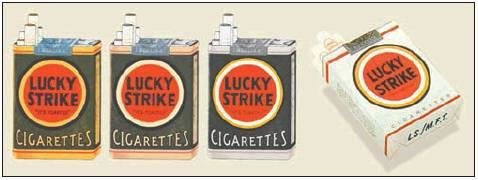Why Lucky Strike really ‘went to war’
HOLY COW! HISTORY
If you are of a certain age, you’ll remember a time when smoking was everywhere. Cigarettes were as common as ants at a picnic. Wherever you …
This item is available in full to subscribers.
Subscribe to continue reading. Already a subscriber? Sign in
Get 50% of all subscriptions for a limited time. Subscribe today.
Please log in to continueNeed an account?
|
Why Lucky Strike really ‘went to war’
HOLY COW! HISTORY
If you are of a certain age, you’ll remember a time when smoking was everywhere. Cigarettes were as common as ants at a picnic. Wherever you went (except church), it seemed someone had one in their hand. Lucky Strike was a popular brand back then. In the popular TV series Mad Men set in the early 1960s, characters went through Lucky Strikes by the carton.
You may even remember Lucky’s (as its fans still refer to the brand) famous World War II slogan, “Lucky Strike has gone to war!” It was advertising gold and pushed sales through the roof. The problem was, the story behind it was untrue. Here’s what really happened.
The name Lucky Strike was first used to sell plug chewing tobacco in 1871. It was soon switched to cigarettes, and Lucky quickly staked out a big share of the market.
The brand solidified its position by utilizing advertising in a big way early on. Lucky Strike became a pioneering radio commercial sponsor in the 1920s. Sales soared.
Yet starting in the 1930s, American Tobacco (Lucky’s manufacturer) discovered a problem. Women had begun smoking during the previous decade. Indeed, cigarettes were an essential element of the “flapper” look that personified the Roaring Twenties. As it became more socially acceptable for them to light up, Lucky Strike sales among female smokers were slowing down. The reason? Many women thought the green and red color on Lucky Strike packages clashed with the color of their clothes.
Lucky hired the services of Edward Bernays, considered the “father of public relations.” American Tobacco swiftly shot down his first suggestion, which was to simply change the package to a neutral color. So he moved on to Plan B: make green fashionable for women’s clothing, and thus eliminate their objection. He kicked off his campaign in 1934 with a “Green Ball” at New York’s Waldorf Astoria Hotel. This highly publicized High Society event featured glamorous ladies dressed in (what else?) elegant green dresses. The ball was a success, but the PR campaign was a flop. Fashion designers didn’t go for green.
American Tobacco fumed. Executives simply didn’t know what to do to make women shoppers reach for Luckies on store shelves.
Then World War II came to the rescue.
After Pearl Harbor plunged our country into the conflict, American businesses eagerly showed in advertisement that they stood solidly behind the war effort. Patriotism, Samuel Johnson famously said, is the last refuge of a scoundrel. American Tobacco seized the opportunity to finally ditch its green packages. And the company explained the change by wrapping itself in the flag.
A massive advertising blitz was launched in 1942, its slogan proudly proclaiming “Lucky Strike has gone to war!” Green was now gone, replaced by a plain white package. The switch was explained in ads by claiming the copper-based green paint that was formerly used for its labels was now being used to paint tanks and ships instead. But it really wasn’t.
Americans enthusiastically embraced Lucky Strike’s selfless “sacrifice.” Sales jumped 40 percent. When all was said and done, “Lucky Strike goes to war!” was one of the most successful advertising campaigns of the 1940s.
And the reason behind it – at least the reason told to the public – was a lie.
As it turned out, it wasn’t the last lie Big Tobacco would tell Americans.
Have comments, questions or suggestions? Message Mark at jmp.press@gmail.com .
Other items that may interest you










Comments
No comments on this item Please log in to comment by clicking here